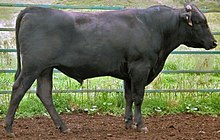Wagyu

Wagyu (和牛, Wagyū, literally Japanese cow) refers to several breeds of cattle, the most famous of which is genetically predisposed to intense marbling and to producing a high percentage of oleaginous unsaturated fat. The meat from such wagyu cattle is known for its marbling characteristics and quality, and demands a high price. In several areas of Japan, beef is shipped with area names. Some examples are Kobe, Mishima, Matsusaka, Ōmi, and Sanda beef.
Wagyu cattle's genetic predisposition yields a beef that contains a higher percentage of omega-3 and omega-6 fatty acids[1] than typical beef. The increased marbling also improves the ratio of monounsaturated fats to saturated fats.
History
Japan

Because of Japan's rugged terrain and isolated areas, different breeding and feeding techniques were used such as massaging or adding beer or sake to their feeding regimen.[citation needed] It is suggested that this was done to aid in digestion and induce hunger during humid seasons, but it appears to have no effect on the meat's flavor. Massaging may have been introduced to prevent muscle cramping on small farms in Japan where the animals did not have sufficient room to use their muscles.[2]
There are four breeds of wagyu: Japanese Black (黒毛和種, Kuroge washu), Japanese Brown (赤毛和種, Akage Washu), Japanese Polled (無角和種, Mukaku Washu), and Japanese Shorthorn (日本短角和種, Nihon Tankaku Washu).[3][4]
Japanese Black makes up 90% of all fattened cattle in Japan.[5] Strains of Japanese Black include Tottori, Tajima, Shimane and Okayama.[6] Japanese Brown, also known as Japanese Red,[5] is the other main breed;[6] strains include Kochi and Kumamoto. Japanese Shorthorn makes up less than one percent of all cattle in Japan.[7]
Australia
The Australian Wagyu Association is the largest breed association outside Japan.[8] Both fullblood and wagyu-cross cattle are farmed in Australia for domestic and overseas markets, including Taiwan, China, Hong Kong, Singapore, Indonesia, the U.K., France, Germany, Denmark and the U.S.A.[9]
Australian wagyu cattle are grain fed for the last 300–500 days of production. Wagyu bred in Western Australia's Margaret River region often have red wine added to their feed as well.
United States
In the United States, Japanese Wagyu cattle were bred with Angus cattle. This crossbreed has been named American Style Kobe Beef.[10]
Designed to mimic the diet that Japanese cattle were receiving, Wagyu cattle in the United States are fed a mixture of corn, alfalfa, barley and wheat straw.
As of 2007, the U.S. cannot ship beef to Japan, as Japan requires that beef imported from the U.S. be from cattle not older than 20 months; U.S. Wagyu cattle are usually slaughtered at 30–35 months.[11]
In Colorado Wagyu beef is being marketed by a ranch near Basalt, Colorado, and by a ranch near Rush, Colorado. Wagyu were first competitively exhibited at the National Western Stock Show in 2012.[12]
References
- ^ Condon, John (2005-03). "Good Fats Boost Wagyu Opportunities". Australian Wagyu Update. Archived from the original on 29 August 2007. Retrieved 2006-12-07.
{{cite news}}: Check date values in:|date=(help) - ^ "Wagyu Beef History". Kobe-beef.com. 22 March 1998. Retrieved 10 May 2009.
- ^ Porter, Valerie; Mason, Ian Lauder (2002). Mason's world dictionary of livestock breeds, types, and varieties. CABI. p. 66. ISBN 0-85199-430-X.
- ^ "What is Wagyu?". Japan Meat Information Service Center.
- ^ a b "Wagyu Japanese Beef" (PDF).
- ^ a b "Wagyu - What are they? Where did they come from?".
- ^ "Japanese Shorthorn Cattle".
- ^ "Australian Wagyu Forum".
- ^ According to the Australian Wagyu Association: http://wagyu.org.au/index.php?option=com_content&task=view&id=13&Itemid=64
- ^ Associated Press, "U.S. ranches breed famous Kobe-style beef", Japan Times, 12 August 2011, p. 3.
- ^ http://www.wagyu.org/JapanLabeling01.doc
- ^ Raabe, Steve (11 January 2012). "Tender Wagyu muscles onto meat scene, makes stock-show exhibition debut". The Denver Post.
Further reading
- Hongo, Jun (6 July 2010). "Despite 'wagyu's' history, foot-and-mouth hit hard". The Japan Times. FYI (weekly column).
External links
- Wagyu Registry Association Template:Ja
- American Wagyu Association
- Australian Wagyu Association
- Canadian Wagyu Association
- European Wagyu Association
- German Wagyu Association
- Austrian Wagyu Association
- Wagyu Research and Information Department of Animal Sciences, Washington State University
- "Breeding History of Japanese Beef Cattle...", Professor Kiyoshi Namikawa, Department of Animal Sciences, Kyoto University – Kyoto, Japan, circa 1985
